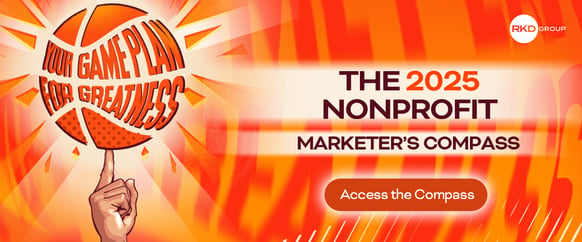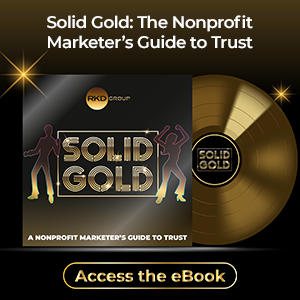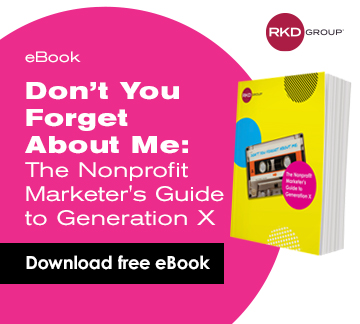That statement has raised eyebrows in recent conversations I’ve had with our clients.
Most nonprofits don’t think of themselves as brands. In fact, it may as well be profane to some. They are nonprofits, after all—not commercial companies. They’re bringing good into the world, not hawking insurance or a gadget you’ll forget about in a year.
Fundraising is branding, but branding is not fundraising.
Fundraising is branding because your brand is more than a logo, product or service: it’s the way people feel when they think about you.
It’s affinity.
But the inverse isn’t true. Brand communication isn’t fundraising because its purpose is distinctly different from that of fundraising.
What is nonprofit brand communication?
Brand communication defines who you are, what you stand for and why it matters. It’s how donors decide whether your values align with theirs, a growing driver of giving today. The goal isn’t a quick donation (though that’s always welcome) but lasting awareness, trust and credibility.
Brand campaigns plant the seeds of support. Through consistent visuals, messages and emotionally resonant stories, they make your mission recognizable and your impact unforgettable.
Over time, strong brand awareness builds trust, turning casual observers into advocates, volunteers and donors. The stronger your brand, the faster that journey from awareness to action.
What is nonprofit fundraising communication?
Fundraising communication drives action right now. Its goal is immediate: a donation, pledge or act of support. These messages are targeted, urgent and emotionally charged. They spotlight a problem, offer a clear solution and invite the recipient to be part of that solution today. Stories, stats and tailored calls to action show exactly how each gift makes a difference.
If brand is a marathon, fundraising is a sprint. Campaigns are time-bound, centered on a single need or initiative and measured by results. Every message moves supporters from empathy to action.
The audiences differ, too:
- Brand communication casts a wide net inclusive of supporters, clients, policymakers and the public.
- Fundraising communication zooms in on current and potential donor audiences, fine-tuned to what inspires their generosity.
Both rely on data-driven segmentation and feedback. The difference lies in the target and the ask.
Content, tone and psychological triggers
Brand messaging inspires and informs. Its tone is confident, consistent and reassuring, building trust and long-term alignment. Your stories should focus on vision and impact, inviting audiences to see themselves as part of your ongoing journey. I’m sure you see how that description plays a role in fundraising, however …
Fundraising appeals move people to act. Their tone is urgent and personal, designed to tap into empathy and motivation. Research consistently shows donors respond most to a single, relatable story (the “identifiable victim” effect) and are influenced by social proof, suggested gift amounts and genuine gratitude. Effective appeals make the impact tangible and the action clear because people give when they feel deeply and know their response matters.
Why branding and fundraising teams must communicate differently
Brand building plays the long game. It creates emotional connections and trust, even when supporters aren’t ready to give. Fundraising turns that trust into action, showing how their involvement can make a difference right now.
That’s why marketing and fundraising teams must stay aligned in purpose but clear in focus. Consistent yet distinct messaging ensures donors recognize your voice, understand your impact, and feel both emotionally inspired and intellectually confident to give.
To blend the two approaches, you must:
- Align on core values: Every brand and fundraising message should reflect the same mission and beliefs.
- Bridge through storytelling: Connect your long-term vision (brand) to today’s urgent needs (fundraising).
- Collaborate and share insights: Regular cross-team check-ins and shared data build understanding, reduce friction and keep everyone moving in sync.
That is to say, work collaboratively, knowing you have the same mission but different goals.
What fundraisers can do today
Fundraising isn’t the place to test a new brand. It’s where you apply it. But if you do want to measure how brand updates affect fundraising results, there’s a smart way to do it.
Donor audiences vary widely in sensitivity to brand changes. Some react strongly to even subtle shifts; others show little difference at all. To get meaningful insights, test boldly but control tightly.
Keep your control version standard. Then create a test version identical in format and offer but fully embodying your new brand direction: refreshed messaging, logo, photography and tone.
This clear contrast reveals whether your brand evolution truly moves the needle, separating signal from noise.
Our client Feed the Children is evolving their brand and doing it the right way. We’ve been invited to participate with them to ensure the fundraising strategy evolves in step. From deep brand research to thoughtful implementation, they’re taking a comprehensive approach that will position their organization as an industry leader and fuel fundraising that helps children thrive here and around the world.
The TL;DR
When nonprofits balance brand and fundraising communication, they harness the full power of both.
Brand work builds recognition and trust; fundraising turns that trust into action. Together, they move people from awareness to impact, powered by the psychology of affinity, empathy and purpose.
Organizations that understand this balance don’t just raise more money, they build deeper relationships and deliver greater impact in the communities they serve.






Leave a comment: